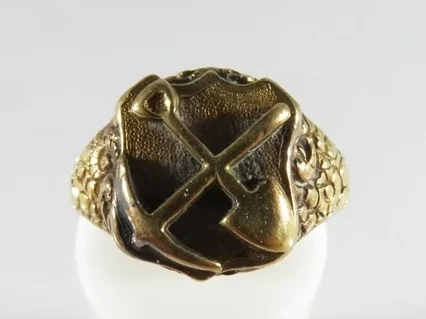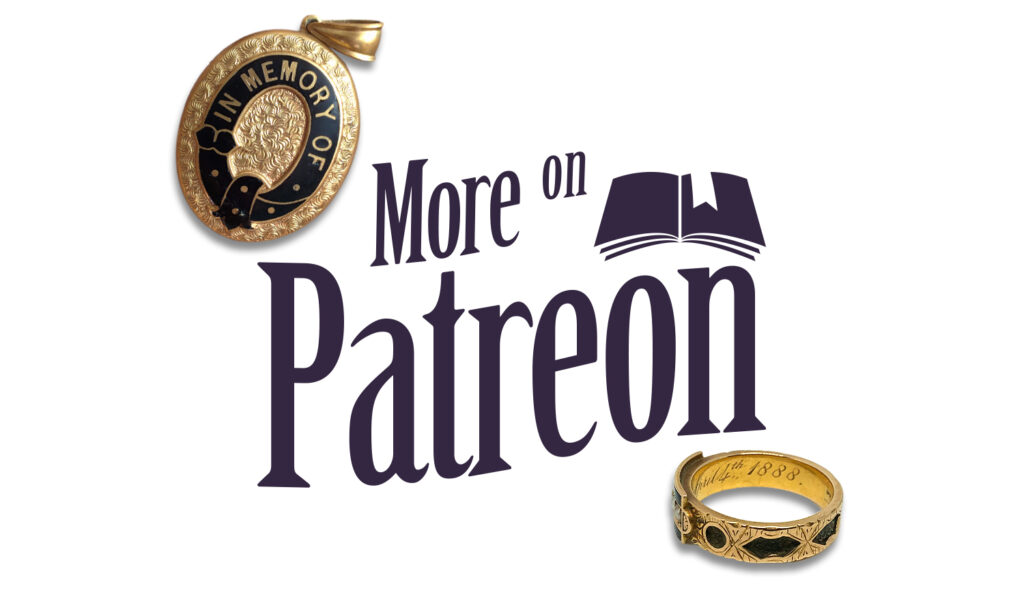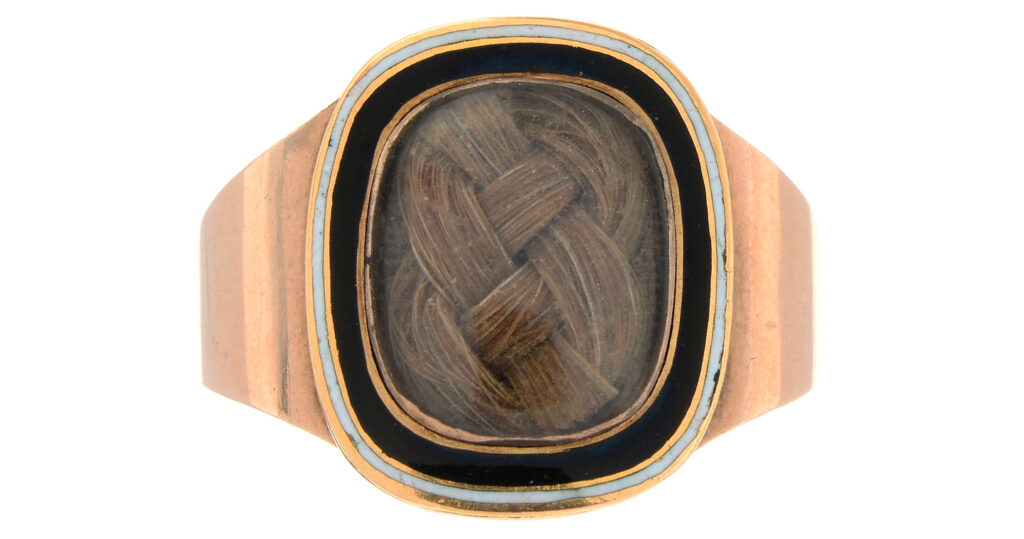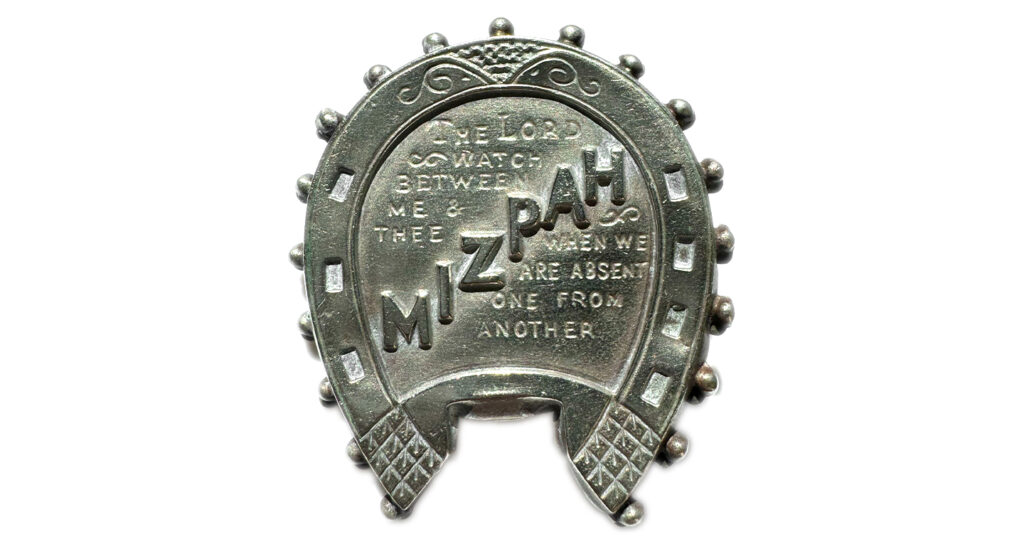Australian Jewels and William Lamborn Part 1
For the 19th century jeweller, the prospect of colonial Australia would have been a mystery filled with the unknown. The colony of New South Wales was established by Captain Arthur Phillip in 1788, bringing with it seven hundred and seventy eight convicts, which grew to thirty six thousand, five hundred and ninety eight inhabitants, both free and convict in November 1828.
Living standards were generally harsh, with male convicts issued two jackets and female convicts only one. Draper’s shops, known then as ‘warehouses’, did not exist in the colony and a raft of illegal and legal auctions and private barter facilitated the convicts’ need for new clothes. The colony was not prepared for the growing population, as even agriculture was almost non-existent. Woolen cloth was produced from a government factory in Parramatta from 1804, but due to the breeding of the sheep, the wool was only fit for ‘slop’ clothing (working clothes) and it wasn’t until the 1820s that Merino wool was of a good enough quality to export.
From the New South Wales 1828 census, there were jewellers of trades. These trades were watchmakers, clockmakers, silversmiths and engravers. Thirty-two of these were jewellers and only six were free settlers.
- Alexander Dick, who employed one jeweller and one watchmaker.
- James Oatley, who employed two watchmakers and two silversmiths.
- Issac White, who employed a silversmith and clockmaker.
- James Robertson and Joseph Davies:, who employed 1 watchmaker.
- William Moreton: Sydney Gazette 1803, 15th May – “Miniatures mounted, Devices in Hair for Rings, Pins and Lockets: Gold Chains, Seals, Fancy Rings, Pins, Ear-rings, Necklaces &c, &c”
Samuel Clayton, an engraver, was born in 1783 in Dublin, Ireland and passed away in 1853. He was a painter and engraver who was convicted of forgery. On December 20th, 1816, he arrived with fifty-eight other convicts to spend seven years of his sentence. He was thirty-three years old and developed a generous business for himself not long after.
S. CLAYTON, Engraver, Likeness Painter, and Teacher of Drawing, No. 23, Pitt-street, Sydney, has now ready for practice a much improved and systematic Machine for taking Likenesses, in profile, on a most correct principle, and in a few minutes, at ten shillings each, on Bristol card, such as is now the London style, and particularly portable, as they may be conveyed in letters to relatives or friends, without injury, to any part of the world.
N. B.-Jewellery and Silver Work made and repaired, Old Gold and Silver bought or exchanged.
There is a reference here to the ‘physiognotrace’, a device used by the portrait artist Charles Balthazar Julien Févret de Saint-Mémin (1770-1852) to design profiles in jewellery for such famous people as George Washington.
This shows considerable development for early Australia, especially at a time where free settlers did not have a lucrative reason to explore the new colonies. Demand for jewellery and fashion was driven by the families of the English officers who arrived at the colonies, which would not drive enough revenue growth for a free settler to launch a competitive business in the 1830s. The establishment of further colonies led to a greater influx of settlers and their families. Van Diemen’s Land, now known as Tasmania, was settled in 1803, its penal colony known as Port Arthur taking in up to seventy-three thousand convicts until the abolition of penal transportation in 1853. European settlers in the island grew from 4,350 to more than 57,000 between 1820 and 1840.
Moreton Bay was established as a penal colony in 1824 on the Brisbane River and grew further in 1839 for free settlers and agricultural businesses. It remained a colony of New South Wales until 1859, when it succeeded. Western Australia was a free colony since its establishment in 1826 on behalf of the New South Wales colonial government. Due to a labour shortage, it introduced a convict labour force and was announced a penal colony in 1849.
In 1836, Adelaide was the first free settlement in Australia, established as a place of social reform and religious freedom. This progressive attitude did away with the need for a police force, which was soon changed to a police force being required in 1838.
Throughout these years and the clear growth of the Australian colonies, there is generational growth from the convicts who became free citizens and their families. Now they were given tickets of leave, which allowed them to work where they wanted to within a police district and apply the skills of their trades where applicable. There still isn’t the immediate investment in the colonies to promote business and the rapid pursuit of wealth. Supply needs to be driven by demand, but there isn’t a clear demand for more than essential items in Australia.
In May, 1835, John Batman explored the area now known as Melbourne. He reportedly negotiated a contract of land from the Wurundjeri elders and selected a place on the Yarra River to settle. Another group followed in August 1835 and decided another place to settle along the Yarra River. They both joined together and claimed the area as ‘Dootigala’, the native name for the land. Richard Burke, the New South Wales governor broke the treaty between Batman and the Wurundjeri, moving ahead to establish the city of Melbourne on May 10th, 1836. Founded as the Port Phillip District of New South Wales, its growth as a free colony was rapid. By 1850, Melbourne established a population of seventy-seven thousand, while Sydney was at sixty thousand. Pastoral licensees, which was the permission for crown land to be leased to an individual, promoted the growth of agriculture and population. Known as ‘squatters’, these people would control the land for the purposes of farming, which was growing more lucrative through sheep and cattle. Greater control of this was held by a select group of people in the Port Phillip District, who called for Crown land to be removed from New South Wales governance. In 1851, Port Phillip District separated from New South Wales and Became the Colony of Victoria.
Elements of hierarchy through affluence were appearing, removed from the convict settlement that had come before. Australian currency had only been introduced in 1813, known as the ‘holey dollar’, where £10,000 sent by the British government to produce currency were stamped and cut. This created the ‘hole’ in the centre of the coin. This was replaced in 1822 by the sterling currency and they disappeared from circulation by 1829. Medical care was provided by the Colonial Medical Service and not yet an established society in its own right, this would occur in 1850. For the European or American looking towards Australia for financial gain, there seems to be little more than satisfying the local market for necessity. Skills, crafts and industry were lacking. Compared to the industrial British Isles, the colonies were a primitive world away from what was being produced in high volumes. Australia needed a reason to attract international attention for its seeming worth and this would happen rapidly, drawing the eye of the world to one of the most lucrative areas on the planet.
Rumours of gold being found in Australia had persisted from 1823, when a convict was given one hundred and fifty lashes near Bathurst for carrying a nugget of gold. He refused to divulge where he had discovered the gold and it was assumed that it was the remnants of a stolen gold watch, which was melted down. Smaller finds of gold during the 1840s were discovered in Victoria and New South Wales, with the largest being reported by Edward Hargraves on the 12th of February, 1851 in Summerhill Creek, NSW. It was the discovery of gold on the 20th of July, 1851 in Mount Alexander, Victoria, that led to the richest gold rush the world had ever seen. On the 27th of September, 1851, ten thousand ounces of gold were sent to Melbourne. Thomas Hiscock is credited with founding the Ballarat goldfields in August, 1851, however it was John Dunlop and James Regan who panned the first gold of the Ballarat diggings in Poverty Point. This would yield twenty million pounds of gold over time and capture the world’s focus. From an outpost of a sheep-run to the place where any regular person could cement their fortune and create a new life for themselves, Ballarat and the Victorian goldfields were the epicentre for opportunity.
William Lamborn, the son of Robert and Ann (née Ripley) Lamborn was born in Holborn, London on September 5th, 1826. He arrived in Melbourne on November 4th, 1852 and quickly established himself as a prominent jeweller with a successful business. His children eventually took over the business, after a prosperous and fruitful career, which has led to some of the most engaging Australian design influenced jewels. Designing jewels with Australian flora and fauna was natural to his work, as if he was second generation Australian born. The marrying together of these symbols and traditional British sentimentality grew the interest in Australian jewels, even if other jeweller more notorious Australian jewellers received more focus.
What is exceptional about William Lamborn is not just his life and times, but the times he grew up in and developed his business within. It took into account the rise and fall of the Victorian colony, which held the international gaze due to its high volume of gold excavation and rapid growth. Emigrating to a colony in pursuit of profit towards a land that is uncertain, largely undeveloped and ultimately foreign to the land he grew up in would have been ultimately a gamble with the possibility of no return.
This essay will follow the life and times of Mr Lamborn and correlate these with the jewellery produced, the designs and their symbols, how it was to live in Melbourne, the second-largest city in the British Empire.
Born in September 5th, 1826, Holborn, England
Born in Hatton Garden, it is no wonder that Lamborn’s future as a jeweller was assured. Widely associated as the centre of jewellery making in London, the assaying office of Pervical Johnson was established there in 1822, which became the global metallurgy and instrument firm Johnson and Matthey. Jewellery stores featured the most popular and exclusive designs, which constantly changed as new influences would emerge locally and abroad.
Lamborn’s growth in the 1820s and 1830s was influential in the designs of jewels that he would go on to design and produce. British designs of jewels from the 1820 period onwards have strong ties to the values of the Middle Ages, which was a reaction of the craftspeople to show the values of their craft against the mechanised Industrial Revolution. Automation, tooling and steam power were removing the craft from the jewellery construction process. This, in turn, would remove the tailoring of a jewel for a loved one, opening up a global market for ubiquitous and generic designs. Growing retailers and department stores could offer these at cheaper prices to a demanding public. This was only exacerbated by the 1854 Hallmarking Act, which allowed for lower grade alloys to be used in jewellery construction.
Since the 1780 Gordon Riots, where over one thousand people were killed in anti-Catholic protests, there had been political tension. The 18th century grew the values of the Enlightenment, with its influence of John Locke’s right to “Life, Liberty and Property”, empowering those who felt underprivileged to fight for their equality. The 1789 storming of the Bastille and the subsequent fallout from this was a sharp reminder to the British that this could happen on local soil.
Religious tension was a spark that could have destabilised the United Kingdom and growing pressure from ‘dissenters’ (those who do not acknowledge the supremacy of the Anglican Church). Dissenters could not take degrees at established universities, such as Oxford and Cambridge, until 1871 and could not take a seat in Parliament. Acquiescence to this was to avert a civil war with Ireland, leading to the Catholic Relief Act in 1829 by Prime Minister Robert Peel.
Religiously, a push back to the values of the Catholic Church was felt by a group from Oxford University. There was a feeling that the Church of England was lacking in the ceremony, grace and values of the Catholic Church. A series of ninety documents were produced by this group, known as ‘Tractarianism’, between 1833 to 1841. This ‘Oxford Movement’ was initially popular, but fell out of favour.
From a design perspective, it is the impact of these values which enforced the styles that would come. The 19th century is known for its classical revivals, but the Gothic Revival movement that would become all-pervasive by the 1830s dominated the rest of the century with the influences of flora and fauna laid within the Baroque designs.
Use of the natural world in jewellery design is especially prominent in the work of William Lamborn, transferring the standard English designs of the forget-me-not, ivy, rose and acanthus for Australia flora and fauna. Gothic Revival styles are meant for dominance. The large, opulent and highly embellished motifs that borrowed from Baroque and Rococo were reminders of earlier times, pre-industrialisation, when people lived in smaller communities and craftspeople did more with their art.
None was more influential in this movement than William Northmore Augustus Pugin, an architect and designer. Credited with designing the Palace of Westminster, his philosophy of using the popular Gothic style can be seen in his polemical book ‘Contrasts’, where he displays an image of 1830s life alongside an image of 15th century lifestyle. This is to show that industrialisation, overpopulation and the cities that had modernised within years was creating a social downfall.
John Ruskin and William Morris, the fathers of the Arts and Crafts movement credited Pugin for his values. Their zeal to create true craftspeople through guilds in the place of machines connects to the creation of Australian designed jewellery. Australian jewels and their designs have an immediacy in their styles. Some depict shovels, pick axes and even the miners themselves, along with Australian banksias, wattle and animal life.
There is a balance of the designs of Australia in the jewels of Lamborn, some with the traditional fig, blended with a kangaroo and emu. The more popular an event, place or time became, the creation of crafted sentimental jewellery was produced.
By the 1840s, many designs of the Gothic Revival had been popularised by the young Queen Victoria and her husband Albert, creating a demand for similar jewellery. On the announcement of their engagement in 1839, Victoria’s gift was an 18 carat gold serpent engagement ring. From this, even the serpent motif swiftly became a popular motif in jewellery.
Jewellery designs are driven by the popular symbols of their contemporary times. For British jewels, the symbols of prosperity are often the ones that are used to represent the individual’s identity. While a serpent may represent eternal love for the Victorians, the jewels of colonial Australia became popular identifiers of personal wealth and the prosperity of the British Empire.
Australian fauna and flora symbols in jewels did not happen upon the immediate start of the gold rushes, but developed as the colonies developed into financial landmarks for the British and cultural curiosities for an empire where the ‘sun never set’.
4th November 1852 – 1869: A Moment in Melbourne
In 1851, the Victorian Government announced that anyone who could find gold within two hundred miles of Melbourne would be awarded £200. Gold was found at Clunes, Ballarat, Castlemaine and Bendigo within six months. A year later, on the 4th of November, 1852, Lamborn set foot in the town of Melbourne.
One can only imagine the sight of arriving in Melbourne in 1852. Lamborn had left the wealthiest and most densely populated city in the world to arrive in a town that was treated as a supply station for patrorialists. The hope and potential of a future and a better life was not assured. The infrastructure of a town that housed twenty nine thousand people at the start of the gold rush expanded with an influx of seventy-five thousand people in 1852.
Source: State Library of Victoria
Photo: Stringer, Mason & Co.
A city not fitted with the amenities of London, or even a reservoir for fresh water, the twenty-two year old Lamborn must have been confident in his craft in order to forge a career and make an impact.
With thousands of people arriving daily to Melbourne, the lodging houses and hotels were completely full. To satisfy the volume of people, iron, timber and canvas houses were erected. Along the south bank of the Yarra River in Emerald Hill, many emigrants pitched tents to prepare for their exodus into the gold fields. Wealth was not guaranteed from the goldfields, as the sheer influx of experienced and non-experienced people was balanced by the ease of extraction of gold. Alluvial gold did not require heavy digging and could be easily panned. When this was exhausted, those who were knowledgeable in their craft could mine deeper for gold. The lifestyle in Melbourne reflected the headiness of the successful miners, with ‘one hotel maid was rumoured to have made a fortune by collecting gold sweepings off the carpets’.
It wasn’t until the 1880s that silver was predominantly used in sentimental jewellery construction. Primarily, the most desirable non-gem material used for a jewel was gold. The relationship between Australia and the jeweller was forged in the goldfields, moving beyond the affectations of wealthy families. Australia marked a place where a person could go to be self-made and what better way to commemorate this than a sentimental jewel?
Lamborn must have seen his place in the market for his potential business to thrive. A jeweller trained in London was bringing his skills and pedigree to the affluent and impressionable gold miners. With the amount of gold being pulled from the earth, it’s no wonder that a business could be made from such raw material. Lamborn wasn’t the only jeweller available, with many others emigrating and some already established.
Port Phillip Gazette, October 26, 1839.
Melbourne had an early history of jewellers, such as Henry Ley, who moved from Sydney to establish his store in 1839. These early jewellers produced and re-sold inventory of their own and internationally. Growth of settler’s families and those who were wealthy enough to control a market for export could afford fine jewellery.
Others, such as C. Macfarlane of 178 Elizabeth Street and J. Tucker of 13 Collins Street, who would announce “GOLD! GOLD! GOLD!” to purchase any amount of gold for their jewellery and watchmaking industries.

This was the time for a jeweller to prosper, as access to alluvial gold was relatively easy for miners. Opportunity could be seen in the lack of professional jewellers who could craft this gold into a sentimental token, causing international interest from Europe and America to quickly establish their craft in this market. Skills were needed, education for the development of these skills were lacking and gold was plentiful. It is not difficult to see just how lucrative this would be for Lamborn to establish himself, yet this is not such an easy task.
Lamborn moved rapidly to establish a family. On the 24th of August, 1853, William Lamborn married Eliza Dennis at St James Cathedral, on the corner of Collins & Williams St. This was barely nine months since his arrival in Melbourne, much unlike that of an established person whose class had a ‘social position’. £250 was the average acceptable wage for a bank clerk to marry, yet for a labourer, £3 per week was enough to establish a family. At this time, the reliance on social presence through accoutrement, be it for the person or the home, was at a time not seen in early modern history. The Industrial Revolution allowed people of middle classes to appear more valuable than their worth and offer social mobility that had been denied previous generations.
Marriages to obtain a title or property were organised by the parents of families, with contracts being signed and gifts being offered. By the 1850s, this was relegated to the upper echelon of society, while the middle and lower classes needed to at least establish a home for their future families. Putting one’s house in order was paramount to being a provider. Those who exploited the goldfields for the instant gratification of wealth often spent their new wealth on instant gratification, while Lamborn was swift to create a family. This shows confidence in the young man that he could achieve success in an uncertain land.
Commercialisation was supported by the Queen and her family, who popularised events such as the Christmas tree, gift giving, cards, the white wedding and sentimental jewellery as interpersonal tokens of affections. Having industries that could produce these items leads directly into the jewellers of the time. A population that is leaping ahead and a generation of colonists who are having children require the social proprietaries of having a wedding ring or a mourning ring made for the event. With greater demand comes the need for supply. This alone should be enough to ensure that someone with the London training of Lamborn could satisfy the market with desirable jewellery.







